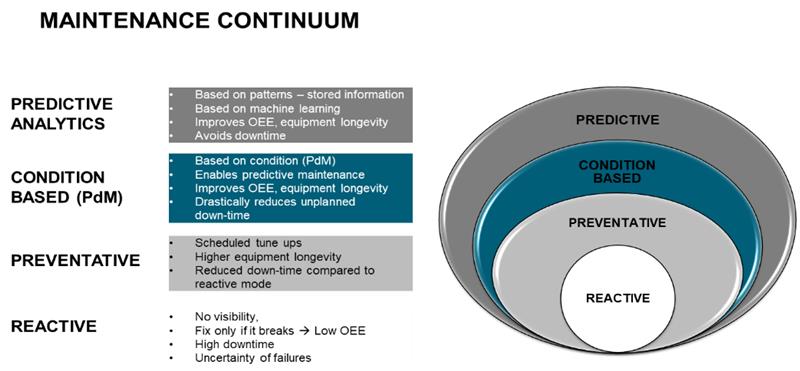
With more and more customers getting onboard with IIoT applications in their plants, a new era of efficiency is lurking around the corner. Automation for maintenance is on the rise thanks to a shortage of qualified maintenance techs coinciding with a desire for more efficient maintenance, reduced downtime, and the inroads IT is making on the plant floor. Predictive Maintenance and Predictive Analytics are part of almost every conversation in manufacturing these days, and often the words are used interchangeably.
This blog is intended to make the clear distinction between these phrases and put into perspective the benefits that maintenance automation brings to the table for plant management and decision-makers, to ensure they can bring to their plants focused innovation and boost efficiencies throughout them.
Before we jump into the meat of the topic, let’s quickly review the earlier stages of the maintenance continuum.

Reactive and Preventative approaches
The Reactive and Preventative approaches are most commonly used in the maintenance continuum. With a Reactive approach, we basically run the machine or line until a failure occurs. This is the most efficient approach with the least downtime while the machine or line runs. Unfortunately, when the machine or line comes to a screeching stop, it presents us with the most costly of downtimes in terms of time wasted and the cost of machine repairs.
The Preventative approach calls for scheduled maintenance on the machine or line to avoid impending machine failures and reduce unplanned downtimes. Unfortunately, the Preventative maintenance strategy does not catch approximately 80% of machine failures. Of course, the Preventative approach is not a complete waste of time and money; regular tune-ups help the operations run smoother compared to the Reactive strategy.
Predictive Maintenance vs. Predictive Analytics
As more companies implement IIoT solutions, data has become exponentially more important to the way we automate machines and processes within a production plant, including maintenance processes. The idea behind Predictive Maintenance (PdM), aka condition-based maintenance, is that by frequently monitoring critical components of the machine, such as motors, pumps, or bearings, we can predict the impending failures of those components over time. Hence, we can prevent the failures by scheduling planned downtime to service machines or components in question. We take action based on predictive conditions or observations. The duration between the monitored condition and the action taken is much shorter here than in the Predictive Analytics approach.
Predictive Analytics, the next higher level on the maintenance continuum, refers to collecting the condition-based data over time, marrying it with expert knowledge of the system, and finally applying machine learning or artificial intelligence to predict the event or failure in the future. This can help avoid the failure altogether. Of course, it depends on the data sets we track, for how long, and how good our expert knowledge systems are.
So, the difference between Predictive Maintenance and Predictive Analytics, among other things, is the time between condition and action. In short, Predictive Maintenance is a stepping-stone to Predictive Analytics. Once in place, the system monitors and learns from the patterns to provide input on improving the system's longevity and uptime. Predictive Maintenance or Preventative Maintenance does not add value in that respect.
While Preventative Maintenance and Predictive Maintenance promises shorter unplanned downtimes, Predictive Analytics promises avoidance of unplanned downtime and the reduction of planned downtime.
The first step to improving your plant floor OEE is with monitoring the conditions of the critical assets in the factory and collecting data regarding the failures.
Other related Automation Insights blogs:
- Condition Monitoring & Predictive Maintenance: Cost-Benefit Tradeoffs
- Condition Monitoring & Predictive Maintenance: Machine Failure Indicators & Detection Methods
- How Condition Monitoring Has Evolved and Its Role in IIoT
- Controls Architectures Enable Condition Monitoring Throughout the Production Floor
- Improve OEE, Save Costs with Condition Monitoring Data
- Getting Condition Data From The Shop Floor to Your Software
